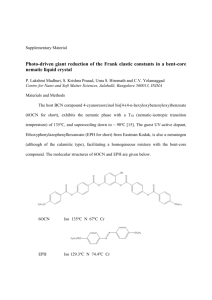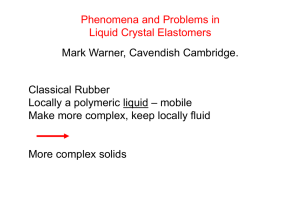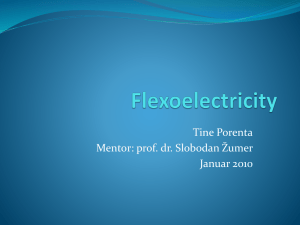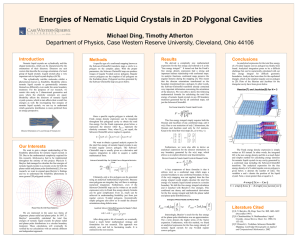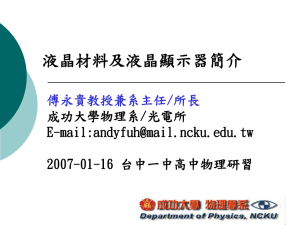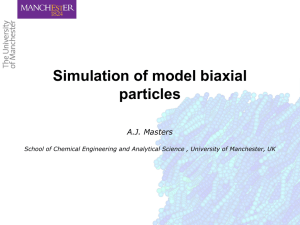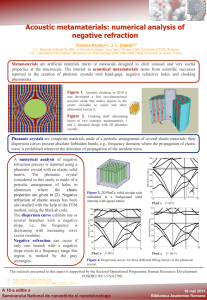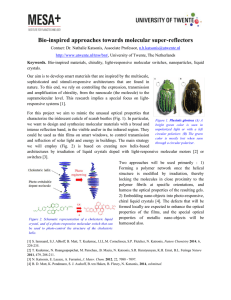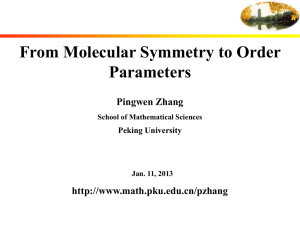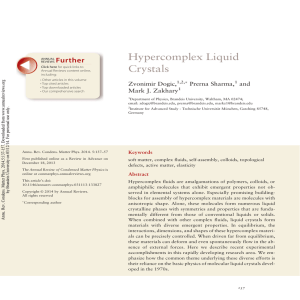Computer Modeling of Nematic Liquid Crystals
advertisement
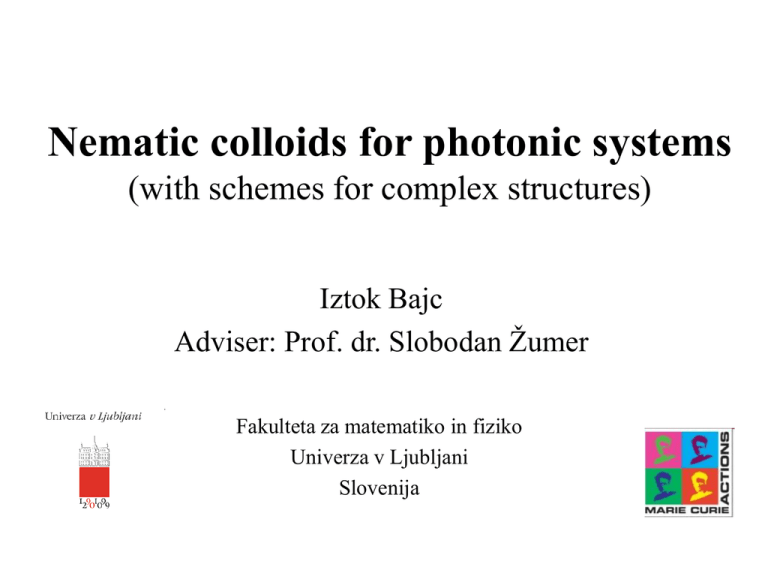
Nematic colloids for photonic systems (with schemes for complex structures) Iztok Bajc Adviser: Prof. dr. Slobodan Žumer Fakulteta za matematiko in fiziko Univerza v Ljubljani Slovenija Outline • • • • • • Motivations, classical and new applications Nematic liquid crystals Colloidal particles in nematic Modeling requirements for large 3D systems Test calculations (3D) Future work: external fields for photonic systems Motivations, classical and new applications Motivations Why to approach this thematic? • • Interesting and fast evolving field. Liquid crystals well represented field in Slovenia. • New potential applications: • Metamaterials. • Microcavities - microresonators. • • M. Ravnik, S. Žumer, Soft Matter, 2009. (Hot topics!) One of the priorities of the EU project (Hierarchy) in which I’m involved. Requirement of very effective modeling codes. Challenge to find the right approaches. M. Humar, M. Ravnik, S. Pajk, I. Muševič, Nature Photonics, 2009. Classical applications of liquid crystals • LCD (Liquid Crystal Displays). • Eye protecting filters for welding helmets (Balder) Liquid crystals have unique optical properties. • Polarizing glasses for 3D vision New potential applications: metamaterials, microresonators • Photonic crystals: Nematic droplet. Whispering Gallery Modes (WGM ) in a microresonator. • Solid state metamaterials: • Soft metamaterials? Figures: I. Muševič, CLC Ljubljana Conference, 2010. Nematic Liquid Crystals Nematic liquid crystals • • • Liquid crystals are a liquid, oily material. They flow like a liquid... ... but can be partially ordered - like crystals. E • • Molecules are rodlike. Tend to align in a preferred direction. • Electric or magnetic field can change their phase form isotropic liquid to partially ordered mesophase. • (The same happens, if temperature is lowered) Description of nematic liquid crystals • Basic quantities Director n (r ) n 1 Points in preferenced orientation. Scalar order parameter S (r ) 1 S 1 2 Quantifies the degree of order of the orientation: -1/2 ideal biaxial liquid 0 isotropic liquid 1 ideally aligned liquid (all molecules parallel) Alternative description with Q-tensor field New quantity: tensor order parameter Q (r ) : S P Q 3n n I e1 e1 e2 e2 2 2 S its largest eigenvector and n its corrispondent eigenvalue. • Q traceless: • Q symmetric: Q11 Q22 Q33 0 Qij Q ji Only 5 independent components of Q are required. Q33 Q11 Q22 Q11 Q12 Q Q22 Q23 Q11 Q22 Q13 Free-energy functional • Director and order nematic structure follow from minimizing the Landau-de Gennes functional: F (Q ) f bulk (Q, Q )dV bulk f bulk f surf (Q, Q )dV border 1 Qij Qij 1 1 1 L AQijQij BQijQ jkQki C(QijQij )2 2 x k x k 2 3 4 Elastic energy Thermodynamic energy L – elastic constants A, B, C – material constants W – surface energy f surf 1 ( 0) W (Q ij - Qij ) 2 Surface energy 2 Colloidal particles in nematic Inclusion of colloidal particles • Inclusion of colloidal particles in a thin sheet of nematic LC. • We get disclination lines (topological defects) around the particles: Strong attractive forces between particles. Colloidal structures -crystals in nematic. Structures of colloidal particles in nematic 1D structures 3D structures 2D structures - crystals Large 3D structures: 12- and 10- cluster in 90° twisted nematic cell. Experiments by U. Tkalec, 2010 (to be published). 3×3×3 dipolar crystal in homeotropically oriented nematic. Experiment by Andriy Nych, 2010 (to be published). Modeling Requirements Computations until now Actual finite difference code in C is: • Robust and effective for smaller or periodic systems. • But uses uniform grid (uniform resolution). Example: A job needs 2h to converge. You double the resolution Then it will run for 2 days. New modeling requirements Mesh adaptivity in 3D, preferably with anisotropic metric. Moving objects (due to nematic elastic forces). Parallel processing (computer clusters). Meshes by Cécile Dobrzynski, Institut de Mathématiques de Bordeaux. Finite Element Method (FEM) Advantages: – Mesh can be locally refined less mesh point needed. – Around each point we have an interpolating function (spline). Newton iteration of tensor fields If function (of one variable): F (Q) F ' (Q) 0 f ' ( x) 0 Newton iteration: Newton iteration: xk 1 xk First variation of functional: f '( x k ) f '' ( x k ) F ' ' (Qk )Qk F ' (Qk ) Qk 1 Qk Qk ( - test functions) Test calculations in 3D: One colloidal particle 2 microns • • • Central section of 3D simulation box mesh Mesh points: 17 000; Tetrahedra: 100 000 Mesh generation’s time: 5 sec (TetGen) 2 microns • • Central section: director field n (in green). Newton’s method took 19 iterations (total time: 54 min). Topological defect 2 microns • • Central section of the order parameter field S. In green: sections of Saturn ring defect. Test calculations in 3D : More particles Future work: external fields for photonic systems Electric field on a nematic droplet E 0 By tuning electric field we switch between optical modes. A large field E change Q. (Q) Also changes. Iteration needed Figures: I. Muševič, CLC Ljubljana Conference, 2010. Electromagnetic waves – linear/nonlinear optics • Detail dimensions comparable with wavelength. 2 microns Ray optics not adequate. • Full system description needed (diffraction,...). • Nematic is a lossy medium. • Also nonhomegeneously anisotropic. Birefringence Computational electromagnetics Basis: Numerical solution of Maxwell equations Computational photonics Mature field for homogeneous medium and periodic structures (e.g. photonic crystals). But young for nonhomegenously anysotropic media ! Computational soft photonics Computational approaches Book Joannopoulos et alt., Photonic Crystals, points out three cathegories of problems: 1) Frequency-domain eigenproblems 2) Frequency-domain response 3) Time-domain propagation [1] Joannopoulos et alt., Photonic Crystals, Molding the flow of Light, 2nd ed, Princeton University Press, 2008. 1) Frequency domain eigenproblems • Seeking for eigenmodes. • Aim: band structure (k ) of photonic crystals. 2 1 (r ) H H Eigenequation c (+ condition) H 0 • Periodic boundary conditions. • Reduces to a matrix eigenproblem: Ax Bx 2 Pictures from site of Steve Johnoson (MIT). 2) Frequency domain responses • Seeking for stationary state. • Aims: absorption & transmittivity. • At fixed frequency ? . 1 E H i H c t c 1 H (r ) E J i E c t c + Absorbing Boundary Conditions (ABC). • Reduces to a matrix linear system: Ax b 3) Time-domain propagation Time evolution of electromagnetic waves. ? ? ? ? Micro-waveguides? Micro-optical elements? Start with FDTD (Finite Difference Time Domain) numerical method: 1. Ready code freely available. • Easily supports nonlinear optical effects. • Gain feeling and experience for smaller systems. Next: possibility of passing to FEM will be considered. Acknowledgments: • Slobodan Žumer (adviser) • Miha Ravnik, Rudolf Peierls Centre for Theoretical Physics, Univerza v Oxfordu, in FMF-UL. • Frédéric Hecht, Laboratoire Jacques-Louis Lyon, UPMC, Paris 6. • Daniel Svenšek • Igor Muševič • Miha Škarabot • Martin Čopič • Uroš Tkalec Work has been finansed by EU: Hierarchy Project, Marie-Curie Actions

